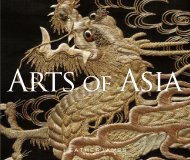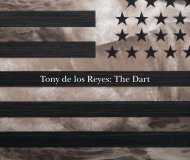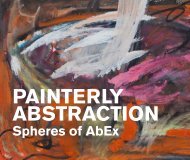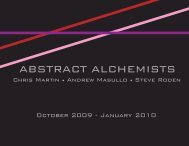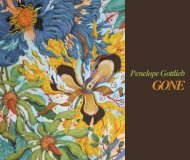EARL CUNNINGHAM: American Fauve - Heather James Fine Art
EARL CUNNINGHAM: American Fauve - Heather James Fine Art
EARL CUNNINGHAM: American Fauve - Heather James Fine Art
Create successful ePaper yourself
Turn your PDF publications into a flip-book with our unique Google optimized e-Paper software.
CHRONOLOGY<br />
1893 June 30. Born Erland Ronald Cunningham in Edgecomb, Maine, near Boothbay<br />
Harbor, fifty-nine miles from Portland. Parents are Charles and Elwilda Drake<br />
Cunningham; there are two older sisters and later, three younger brothers. Their<br />
father lives and works on the farm that has been in the family since the early<br />
ninteenth century. According to family tradition, they were of Scottish descent and<br />
had emigrated to Nova Scotia and then moved south to Maine.<br />
1906 Leaves home at age thirteen. His mother makes him promise that he will finish the<br />
eighth grade; his father then pronounces him a man, and he strikes out on his own.<br />
Makes his living as a tinker and is befriended by the son of the inventor and founder<br />
of the Diamond Match Company. Returns to Boothbay Harbor for part of each year<br />
until 1937.<br />
1909 Lives in a fisherman’s shack on Stratton Island off Old Orchard Beach, Maine.<br />
Supports himself by peddling and by painting salvaged wood with pictures of boats<br />
and New England Farms for fifty cents each. Eventually acquires a rowboat, tent, and<br />
a twenty-two-foot sailboat, which he sails to within fifteen miles of New York City,<br />
to Jamaica Bay, Sandy Hook, and Long Island Sound, and even up beyond the<br />
narrows of the Hudson River.<br />
1912 May 1. Receives a certificate from Hamil Foster School of Automobile Engineering,<br />
Portland, Maine. Also finds time to study coastal navigation and receives a<br />
government license as a pilot of harbors and rivers.<br />
Prior to World War I<br />
Sails on giant coastal ships, 159 to 250 feet long, schooner-rigged, with four and five<br />
masts. Travels down the East coast to Florida and ports on the way, carrying coal,<br />
naval stores, and other cargo. Relates the story that he was once taken by “coaster”<br />
to Labrador, Canada, where he was put ashore for two weeks to light a huge bonfire<br />
for the ship on its return. During that time he befriended raccoons, birds, and other<br />
animals, many of which appear later in his paintings.<br />
c. 1913 Meets Captain Foster, skipper of the J. P. Morgan family yacht, the Grace, and<br />
eventually learns to sail the vessel. Saves the Grace from possible disaster by repairing<br />
a shackle that had been undone by the weather. In return for Earl’s diligence, Captain<br />
Foster goes to Boston and returns with an eleven-foot mahogany-topped white cedar<br />
canoe, a gift from the Morgan family. Later, a loan from Captain Foster enables him<br />
to buy a twenty-two-foot sailboat.<br />
1913 June. Postcard from Boothbay Harbor mentions traveling “from Portland, Maine to<br />
Boothbay Harbor on the Grace…Captain Foster’s daughter and I went to the fire<br />
around nine o’clock at night June 1913.” Fire destroys a large hotel called the<br />
Menawarmet.<br />
1914 August. Stays in cabin at Pendleton homestead, Crescent Beach Road, Anastasia<br />
island, Florida. That same year sells a painting for eight dollars.<br />
1915 June 29. Marries Iva Moses, a piano teacher, whom he calls Maggie throughout their<br />
marriage. Buys a thirty-five-foot cabin cruiser named the Hokona, on which he<br />
and his bride live. Drives a truck for the navy during World War I and is sent to<br />
Jacksonville, Florida, to test an instrument used to detect alloys in junk metals. While<br />
on this job visits St. Augustine for the first time.<br />
1916 Hokona is docked near Cape Elizabeth, Maine. Photograph of chickens bears<br />
inscription “product of our farm 1916.”<br />
1917 Photograph of the vessel Bay State grounded on the rocks, Cape Elizabeth, near<br />
Portland, Maine. Later uses this scene in a painting.<br />
1918-c.1928<br />
For a decade after World War I spends the winters in Florida at Tampa Bay, Ceader<br />
Keys, and St. Augustine, digging for Indian relics and collecting opalized coral to take<br />
back to Maine to sell. Also catches fiddler crabs on the beaches of Anastasia Island,<br />
Florida, which he preserves and takes back to Maine.<br />
1919 In Freeport, Maine, and Schenectady, New York.<br />
1920 Lives in Freeport, Maine. Has several buildings and a sawmill.<br />
1921 July. Photograph taken in Freeport, Maine, with the truck named Dirigo: The Good Barge.<br />
July 20. Travels between Florida and Miami.<br />
August 6. Visits Niagara Falls.<br />
August 8. Travels the coast of Lake Erie beyond Lackawanna, New York.<br />
October 14. Spends time in Ohio; the Cunninghams husk eight hundred bushels of<br />
corn for Mr. Riddles.<br />
1922 April. Visits Cartersville, Georgia.<br />
August. Photograph take near Cartersville shows Etowah burial mounds in the<br />
background. On the reverse Cunningham notes, “Found lots of things here: 1922-23<br />
24-25.”<br />
1923-24 Continues to visit Anastasia Island and St. Augustine, Florida. Stays long enough to<br />
invest in a small motorized tractor.<br />
1925 Rents a house in the district of West Augustine, St. Augustine, Florida, for five years;<br />
catches fiddler crabs and sends them to Maine as well as all over the U.S. Continues to<br />
call Maine home; moves from Freeport to Boothbay Harbor.<br />
October 19. Earl’s brother Donald dies in a sawmill accident. Family situation<br />
becomes difficult.<br />
c. 1920s-40<br />
Maintains a twenty-five acre farm in Maine, which he names “Fort Valley,” and plans<br />
a museum.<br />
118





